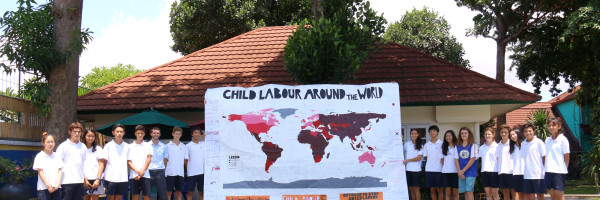International students against child labour
While studying the Industrial Revolution, the grade 9 Individuals and Societies class of Bali Island School was briefly introduced to the issue of child labour. We were appalled with the institution of child labour and we were astonished that it is currently occurring all over the world in this day and age. As a class we decided to go into further depth by researching the factors surrounding the issue and its causes in the modern era. We also wanted to compare the rights and laws guaranteed to protect children in several of our home countries. We therefore created posters on child labour for several home countries written partly in its national language. Through further inquiry into our chosen countries we hoped to demonstrate our understanding of the prevalence of child labour in each nation. Eventually the posters were created and we reached our initial goal.
Instead of concluding our inquiry with the country posters we decided to broaden our research and create a world map that expanded this project to an international scale. Our plan was to also raise awareness regarding the issue by making sure the world map was where audiences could see it. We planned to write letters to the relevant authorities, experts and world leaders related to the issue and call for more action to be taken.
Throughout the process we faced many difficulties and challenges, like all projects, which forced us to modify our plan. We needed to take initiative and use our critical thinking skills to problem solve the many complications which we faced. This is something we do not usually experience in ‘regular’ class work. We needed to be open minded and understanding of one another and communicate as well as collaborate in order to come up with solutions.
The first major problem was how to approach the task at hand and to decide where to draw the map. We initially decided to paint the map on the ceiling of our Individuals and Societies class. We measured the size of the ceiling available for our map, but we encountered another obstacle of how to scale the world map. After extensive research we found a UTM (Universal Transverse Mercator) projection, which offers the most accurate depiction of the earth if it was flat. It achieves this by dividing the earth into almost equal grids of longitude and latitude. This is based on the 180 degrees of latitude and 360 degrees of longitude. We used a UTM projection map to ensure our stencils were to scale. We decided to create a map with 60 grids of latitude by 20 grids of longitude. We applied the skills learnt in Math class, such as ratio and scale, to determine the measurements of the map based on the space available on the ceiling.
It was almost impossible to stick the stencils on the ceiling as we originally planned. After weighing up the pros and cons of doing this, we realised this approach was not safe enough to continue as many students would need to stand on desks. Although our original idea was to create the world map on the ceiling we realised that we had to find a more efficient approach. We finally chose to draw our map on a canvas. However, it was too expensive to buy one or more huge canvas and stitch them together.
We had to again modify our action plan. We decided the best way to do this, would be by making a canvas out of newspapers. Not only would this be environmentally friendly and financially wise, but we believed that this would make our creation process more manageable than the ceiling idea. We all came to a consensus that it would be more convenient if we created our own canvas and taped the stencils on the canvas instead of the ceiling.
In the process of creating the canvas and the posters for it, we incorporated techniques learned in Arts, such as the use of stencils for creating the map of the world. We also used layering and toning to be able to effectively use different colours for child labour danger levels. In order for the stencil to work we needed to use a method called bridging so we would not miss out any inland lakes or islands.
We developed and improved other skills such as problem-solving, critical-thinking and collaboration. This project also forced us to take initiative and fulfill any responsibilities we had, whether it be getting resources or being assigned to research a certain field of child labour. We strongly believe that we have fully explored the fairness and development global context by participating and spreading awareness about children’s rights and responsibilities and expressing how individuals should have equal opportunities. By researching and comparing the prevalence of child labour in each country we have also demonstrated relationships between communities.
The final stage of this project is to send emails to world leaders demanding that they take more visible action against the institution of child labour. We have split our class into pairs and each pair will email an explanation of our project and what we hope the global leaders will do to help fight the problem of child labour. We await the replies from leaders with great anticipation. Let’s hope they listen to us!
Please see below a slideshow of our work.
Written by:
BIS Grade 9 Individuals and Societies Class

